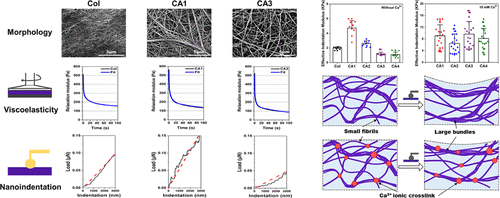当前位置:
X-MOL 学术
›
Biomacromolecules
›
论文详情
Our official English website, www.x-mol.net, welcomes your feedback! (Note: you will need to create a separate account there.)
Micro-/Nanomechanics Dependence of Biomimetic Matrices upon Collagen-Based Fibrillar Aggregation and Arrangement.
Biomacromolecules ( IF 6.2 ) Pub Date : 2020-07-28 , DOI: 10.1021/acs.biomac.0c00584 Wen Su 1, 2 , Yaqin Ran 1, 2 , Lei Ma 1, 2 , Xiaomin Ma 1, 2 , Zeng Yi 1, 2 , Guangcan Chen 1, 2 , Xiangyu Chen 1, 2 , Zhiwen Deng 1, 2 , Qiulan Tong 1, 2 , Xudong Li 1, 2
Biomacromolecules ( IF 6.2 ) Pub Date : 2020-07-28 , DOI: 10.1021/acs.biomac.0c00584 Wen Su 1, 2 , Yaqin Ran 1, 2 , Lei Ma 1, 2 , Xiaomin Ma 1, 2 , Zeng Yi 1, 2 , Guangcan Chen 1, 2 , Xiangyu Chen 1, 2 , Zhiwen Deng 1, 2 , Qiulan Tong 1, 2 , Xudong Li 1, 2
Affiliation

|
The mechanical and morphological cues of fibrillar extracellular matrices (ECMs) play vital roles in controlling the cellular behaviors. Understanding and regulating the correlation of the mechanics with morphologies, at the micro-/nanoscale are of great relevance to guide the growth and differentiation of stem or progenitor cells into the desired tissues. However, the investigations directed toward acquiring such a kind of correlation are very limited and far from satisfactory. Here, rheological and nanoindentation tests were employed to appraise the mechanical behaviors of biomimetic ECMs assembled from type I collagen solutions containing the equivalent content of alginate but with different molecular weights (MWs). An alginate-molecular-weight-dependent trend was found in the fibrillogenesis process and the fibril aggregation of these collagen–alginate (CA) matrices. The present study revealed that the viscoelasticity and nonlinear elasticity of the CA matrices relied upon their specific fibrillar architectures in which a heterogeneous structure formed with varying alginate MW, including the coexistence of small fibrils and larger fibrillar bundles. The correlation of the mechanical behaviors with the inhomogeneity in the fibrillar structures was further discussed in combination with those of Ca2+ ionically cross-linked CA matrices. This study not only presented the delicate mechanics of fibrillar ECM analogues but also showed that the introduction of affiliative matters such as polysaccharides (alginate with different MWs) is a simple and convenient strategy to achieve biomimetic hydrogels with tunable viscoelastic properties.
中文翻译:

仿生矩阵的微观/纳米力学依赖性基于胶原蛋白的原纤维聚集和排列。
纤维状细胞外基质(ECM)的力学和形态学线索在控制细胞行为中起着至关重要的作用。在微观/纳米尺度上理解和调节力学与形态的相关性对于指导干细胞或祖细胞向所需组织的生长和分化具有重要意义。然而,针对获得这种相关性的研究非常有限并且远远不能令人满意。在这里,流变和纳米压痕测试被用来评估由I型胶原溶液组装而成的仿生ECM的机械行为,其中I型胶原溶液含有相同含量的藻酸盐但分子量(MWs)不同。在原纤维形成过程和这些胶原-藻酸盐(CA)基质的原纤维聚集中发现了藻酸盐-分子量依赖性趋势。本研究表明,CA基质的粘弹性和非线性弹性取决于其特定的原纤维结构,其中异质结构形成的藻酸盐分子量各不相同,包括小原纤维和较大原纤维束的共存。结合Ca的力学行为,进一步讨论了力学行为与原纤维结构中的不均匀性之间的关系。包括小原纤维和大原纤维束的共存。结合Ca的力学行为,进一步讨论了力学行为与原纤维结构中的不均匀性之间的关系。包括小原纤维和大原纤维束的共存。结合Ca的力学行为,进一步讨论了力学行为与原纤维结构中的不均匀性之间的关系。2+离子交联的CA矩阵。这项研究不仅展示了纤维状ECM类似物的精细机理,而且还表明,引入诸如多糖(具有不同MWs的藻酸盐)之类的关联物质是获得具有可调粘弹性的仿生水凝胶的简单便捷策略。
更新日期:2020-09-14
中文翻译:

仿生矩阵的微观/纳米力学依赖性基于胶原蛋白的原纤维聚集和排列。
纤维状细胞外基质(ECM)的力学和形态学线索在控制细胞行为中起着至关重要的作用。在微观/纳米尺度上理解和调节力学与形态的相关性对于指导干细胞或祖细胞向所需组织的生长和分化具有重要意义。然而,针对获得这种相关性的研究非常有限并且远远不能令人满意。在这里,流变和纳米压痕测试被用来评估由I型胶原溶液组装而成的仿生ECM的机械行为,其中I型胶原溶液含有相同含量的藻酸盐但分子量(MWs)不同。在原纤维形成过程和这些胶原-藻酸盐(CA)基质的原纤维聚集中发现了藻酸盐-分子量依赖性趋势。本研究表明,CA基质的粘弹性和非线性弹性取决于其特定的原纤维结构,其中异质结构形成的藻酸盐分子量各不相同,包括小原纤维和较大原纤维束的共存。结合Ca的力学行为,进一步讨论了力学行为与原纤维结构中的不均匀性之间的关系。包括小原纤维和大原纤维束的共存。结合Ca的力学行为,进一步讨论了力学行为与原纤维结构中的不均匀性之间的关系。包括小原纤维和大原纤维束的共存。结合Ca的力学行为,进一步讨论了力学行为与原纤维结构中的不均匀性之间的关系。2+离子交联的CA矩阵。这项研究不仅展示了纤维状ECM类似物的精细机理,而且还表明,引入诸如多糖(具有不同MWs的藻酸盐)之类的关联物质是获得具有可调粘弹性的仿生水凝胶的简单便捷策略。


























 京公网安备 11010802027423号
京公网安备 11010802027423号